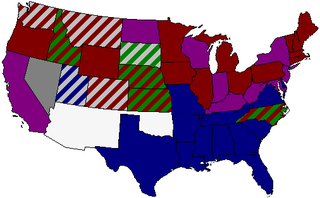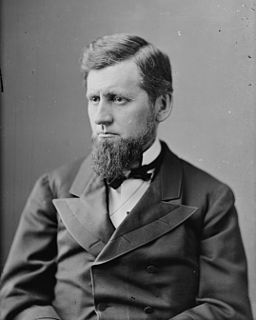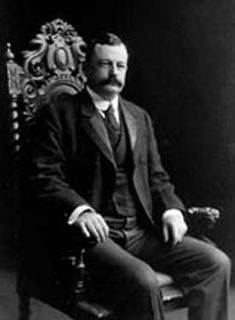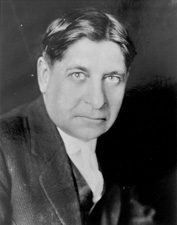
The 1946 United States Senate elections were held November 5, 1946, in the middle of Democratic President Harry S. Truman's first term.

The United States Senate elections of 1908 and 1909, some states elected their senators directly even before passage of the 17th Amendment in 1913. Oregon pioneered direct election and experimented with different measures over several years until it succeeded in 1907. Soon after, Nebraska followed suit and laid the foundation for other states to adopt measures reflecting the people's will. By 1912, as many as 29 states elected senators either as nominees of their party's primary or in conjunction with a general election. The Republicans lost two seats overall.

The 1926 New York state election was held on November 2, 1926, to elect the Governor, the Lieutenant Governor, the State Comptroller, the Attorney General, a U.S. Senator, the Chief Judge and an associate judge of the New York Court of Appeals, as well as all members of the New York State Assembly and the New York State Senate. Besides, a referendum to repeal Prohibition was proposed and accepted by a very large majority.

The 1920 New York state election was held on November 2, 1920, to elect the Governor, the Lieutenant Governor, the Secretary of State, the State Comptroller, the Attorney General, the State Treasurer, the State Engineer, two judges of the New York Court of Appeals and a U.S. Senator, as well as all members of the New York State Assembly and the New York State Senate.

The United States Senate elections of 1896 and 1897 were elections in which the Democratic Party lost seven seats in the United States Senate, mostly to smaller third parties.

The United States Senate elections of 1902 and 1903 were elections which had the Democratic Party gain three seats in the United States Senate, but the Republicans kept their strong majority.

The Pennsylvania Gubernatorial election of 1910 was held on November 8, 1910. The main candidates were Republican John K. Tener, Democrat Webster Grim, Keystone Party leader William H. Berry, and Socialist John W. Slayton.

The 1914 United States Senate election in Pennsylvania was held on November 3, 1914. Incumbent Republican U.S. Senator Boies Penrose won re-election against Gifford Pinchot and Alexander Mitchell Palmer.

The 2012 United States Senate election in Maryland took place on November 6, 2012, concurrently with the 2012 U.S. presidential election as well as other elections to the United States Senate, House of Representatives, and various state and local elections. Incumbent Democratic U.S. Senator Ben Cardin won re-election to a second term, defeating Republican nominee Dan Bongino and independent Rob Sobhani.

The 1926 United States Senate election in Pennsylvania was held on November 2, 1926. Incumbent Republican George W. Pepper, who was appointed following the death of Boies Penrose, was defeated for re-nomination by William Scott Vare. Vare won the election, defeating Democratic opponent William Bauchop Wilson. He was not permitted to assume office, however, until an investigation was conducted into possible election fraud and corruption. Vare was ultimately unseated in December 1929 by the Senate, following charges of corruption.

The 1922 United States Senate special election in Pennsylvania was held on November 7, 1922. Incumbent Republican Senator George Pepper, who had been appointed to the seat by Governor William Sproul following the death of Boies Penrose, was elected to fill the remaining four years on the term to which Penrose had been elected in 1920. Pepper comfortably defeated five other candidates, including Democratic nominee Fred Kerr of Clearfield County.

The 1920 United States Senate elections in Arizona took place on November 2, 1920. Incumbent Democratic U.S. Senator Marcus A. Smith ran for reelection to a third term, but was defeated by former Delegate to the U.S. House of Representatives from the Arizona Territory Ralph H. Cameron in the general election. Cameron would become the first Republican elected to the office of U.S. Senator from Arizona since the state joined the union in 1912. The same year, Republican Governor Thomas Edward Campbell was reelected to a second term.

The 1897 United States Senate election in Pennsylvania was held on January 19, 1897. Boies Penrose was elected by the Pennsylvania General Assembly to the United States Senate.

The 1903 United States Senate election in Pennsylvania was held on January 20, 1903. Boies Penrose was re-elected by the Pennsylvania General Assembly to the United States Senate.

The 1909 United States Senate election in Pennsylvania was held on January 19, 1909. Boies Penrose was re-elected by the Pennsylvania General Assembly to the United States Senate. This was the last Class III U.S. Senate election to be decided by the Pennsylvania General Assembly before the ratification of the 17th Amendment to the U.S. Constitution, which mandated direct election of U.S. Senators.

The 1990 United States Senate election in Montana took place on November 6, 1990. Incumbent United States Senator Max Baucus, who was first elected in 1978 and was re-elected in 1984, ran for re-election. After winning the Democratic primary, he moved on to the general election, where he was opposed by Allen Kolstad, the Lieutenant Governor of Montana and the Republican nominee. Baucus ultimately ended up defeating Kolstad in a landslide, winning his third term with ease.

The 1924 United States Senate election in Minnesota took place on November 4, 1924. Republican U.S. Representative Thomas D. Schall defeated incumbent Farmer-Labor U.S. Senator Magnus Johnson and Democratic challenger John J. Farrell. Johnson, who was elected in the 1923 special election, had been in office for less than a year and a half when his attempt to win a full six-year term was defeated by Schall.


















